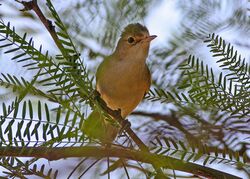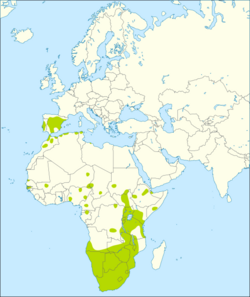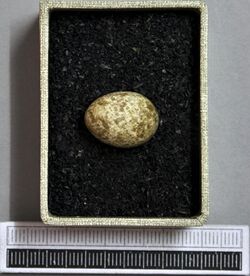Biology:African reed warbler
| African reed warbler | |
|---|---|

| |
| File:Acrocephalus baeticatus - African Reed Warbler XC431998.mp3 | |
| Scientific classification | |
| Domain: | Eukaryota |
| Kingdom: | Animalia |
| Phylum: | Chordata |
| Class: | Aves |
| Order: | Passeriformes |
| Family: | Acrocephalidae |
| Genus: | Acrocephalus |
| Species: | A. baeticatus
|
| Binomial name | |
| Acrocephalus baeticatus (Vieillot, 1817)
| |

| |
| Range | |
The African reed warbler or African marsh warbler (Acrocephalus baeticatus) is an Old World warbler in the genus Acrocephalus. It breeds in much of Africa south of the Sahara. It is migratory within the continent, with southern breeding population moving to the tropics in the southern hemisphere's winter.
This bird is sometimes considered to be a subspecies of the Eurasian reed warbler, Acrocephalus scirpaceus.
This is a common species of marshy areas, with reeds sedges or rank vegetation. When not breeding, it may enter gardens.
Taxonomy
The African reed warbler was formally described in 1817 by the French ornithologist Louis Jean Pierre Vieillot under the binomial name Sylvia baeticata.[1] Vieillot based his description on "L'Isabelle" that had been described and illustrated in 1802 by François Levaillant in his Histoire Naturelle des Oiseaux d'Afrique.[2] The type locality is Knysna in the Western Cape province of South Africa.[3] The African reed warbler is now one of around 40 species placed in the genus Acrocephalus that was introduced by Johann Andreas Naumann and his son Johann Friedrich Naumann in 1811.[4] The genus name Acrocephalus is from Ancient Greek akros, "highest", and kephale, "head". It is possible that the Naumanns thought akros meant "sharp-pointed". The specific baeticatus is from Latin and means "clothed in brown". Baeticus (now Andalucia) was a province of Roman Spain that was famous for its wool.[5]
Six subspecies are recognised:[4]
- A. b. ambiguus (Brehm, AE, 1857) – Iberian Peninsula and northwest Africa
- A. b. minor Lynes, 1923 – Sahel region from Sengal to west-central Sudan (Darfur)
- A. b. cinnamomeus Reichenow, 1908 – west Ethiopia and south Somalia south through South Sudan, Uganda, Kenya, Zambia and Mozambique; patchy distribution in west Africa from south Cameroon to possibly Niger and Mali
- A. b. suahelicus Grote, 1926 – east Tanzania to east Mozambique and east South Africa
- A. b. hallae White, CMN, 1960 – southwest Angola to southwest Zambia and south to west South Africa
- A. b. baeticatus (Vieillot, 1817) – north Botswana and Zimbabwe to south South Africa
Description
The African reed warbler is a plain smallish bird with a somewhat flattened forehead, 13 cm (5.1 in) long and weighing around 11 g (0.39 oz). Its upperparts are rich brown, and it has a weak white supercilium. The underparts are white, with a rufous wash to the flanks. The strong pointed bill has a slightly downcurved upper mandible; it is dull yellow with a yellower base. The legs are black and the eyes are brown. The sexes are similar in appearance, but the juvenile has a rufous rump.
The song is a slow, chattering jit-jit-jit with typically acrocephaline whistles and mimicry added. It is indistinguishable from reed warbler except for the species that are mimicked.
This species can only be safely distinguished from the reed warbler in the hand. However, that species is usually found in much wetter habitats, and is rare or absent from much of southern Africa.
In southern Africa, the main confusion species is the migrant marsh warbler Acrocephalus palustris, and distinguishing these two species is not easy. Marsh warbler is larger, colder brown above, is longer-winged, and has a flatter head profile. It is also found in drier habitats and intersperses more musical phrases in its song.
Behaviour
The African reed warbler builds a deep basket nest from strips of reed blades, grass and sedges, which is lined with finer grasses and placed low in reeds. It lays two to four white eggs. This species is monogamous, pairing for life.
The African reed warbler is usually seen alone or in pairs, moving through vegetation and clambering up and down plant stems. It eats insects and other small invertebrates.
Conservation status
This common species has a large range and the population size is believed to be large. The species is not believed to approach the thresholds for the population decline criterion of the IUCN Red List (i.e. declining more than 30% in ten years or three generations). For these reasons, the species is evaluated as Least Concern.
References
- ↑ Vieillot, Louis Jean Pierre (1817) (in French). Nouveau dictionnaire d'histoire naturelle, appliquée aux arts, à l'agriculture, à l'économie rurale et domestique, à la médecine, etc.. 11 (Nouvelle édition ed.). Paris: Deterville. p. 195. https://www.biodiversitylibrary.org/page/19427958.
- ↑ Levaillant, François (1802) (in French). Histoire Naturelle des Oiseaux d'Afrique. 3. Paris: Delachauchée. pp. 92–93, Plate 121, fig. 2. https://www.biodiversitylibrary.org/page/41423439.
- ↑ Mayr, Ernst; Cottrell, G. William, eds (1986). Check-list of Birds of the World. 11. Cambridge, Massachusetts: Museum of Comparative Zoology. p. 64. https://www.biodiversitylibrary.org/page/14483765.
- ↑ 4.0 4.1 Gill, Frank; Donsker, David; Rasmussen, Pamela, eds (January 2022). "Bushtits, leaf warblers, reed warblers". IOC World Bird List Version 12.1. International Ornithologists' Union. https://www.worldbirdnames.org/bow/bushtits/.
- ↑ Jobling, James A. (2010). The Helm Dictionary of Scientific Bird Names. London: Christopher Helm. pp. 30–31, 65. ISBN 978-1-4081-2501-4.
- Ian Sinclair, Phil Hockey and Warwick Tarboton, SASOL Birds of Southern Africa (Struik 2002) ISBN:1-86872-721-1
External links
- African marsh/reed warbler - Species text in The Atlas of Southern African Birds.
Wikidata ☰ Q2667981 entry



